나노물질








의료 분야에서 웨어러블 전자 장치의 응용 가능성은 지난 수십 년 동안 큰 관심을 받았습니다. 피부 친화적인 부드러운 탄성 소재를 기반으로 하는 유연하고 웨어러블한 장치는 사람의 피부 표면에 편안하게 부착될 수 있으므로 손목 맥박, 체온, 혈당과 같은 일련의 중요한 건강 정보를 추출하고 분석하여 도움을 줄 수 있습니다. 환자는 체력을 유지합니다. 여기서 우리는 힘 센서, 온도 센서, 생리적 생화학 센서 및 다기능 센서를 포함하여 인간 건강 정보를 모니터링하기 위한 가장 일반적인 유형의 웨어러블 전자 장치에 대해 설명했습니다. 그들의 일반적인 작동 원리와 구조적 혁신을 검토합니다. 그런 다음 웨어러블 센서를 실생활에 더 많이 적용할 수 있도록 하는 자체 전원 모듈과 신호 처리 모듈의 두 가지 기능 모듈에 대해 논의했습니다. 인체 건강 정보 모니터링을 위한 웨어러블 전자 장치 개발을 위한 과제 및 향후 연구 방향도 제안됩니다.
1950년대 이후 실리콘 기반 반도체 기술의 부상은 정보 기술 산업의 발전을 크게 촉진하여 사람들의 삶을 극적으로 변화시켰습니다. 그러나 세계 정보화의 가속화와 사물 인터넷(IoT)의 발달로 인해 기존의 실리콘 기반 전자 제품은 영률이 높은 새로운 도전 과제에 직면해 있습니다. 지난 수십 년 동안 유연하고 착용할 수 있는 전자 장치에 대한 관심이 높아지고 과학 세계에서 뜨거운 주제가 되었습니다. 경질 실리콘 기반 전자 장치와 달리 유연 전자 장치는 높은 유연성, 초경량, 순응성과 같은 많은 고유한 우수한 특성을 나타내므로 유연하고 웨어러블 전자 장치를 더 넓은 범위에서 사용할 수 있습니다.
특히, 인간의 건강 정보를 정기적이고 지속적으로 모니터링하기 위한 플렉서블(Flexible)한 웨어러블(wearable) 의료기기에 대한 관심이 높아지고 있다. 생체 신호를 가능한 한 편안하게 지속적으로 모니터링할 수 있는 새로운 장치가 개발되고 있습니다. 이러한 웨어러블 의료 전자 기기는 심박수, 맥박, 체온, 혈당 등 다양한 건강 지표를 인체 표면에 부착하기만 하면 실시간으로 비침습적으로 측정할 수 있다. 생체 신호를 실시간으로 모니터링하면 개인의 신체 건강 지표가 비정상적일 때 사용자와 의료 제공자에게 추가 의료 서비스를 알릴 수 있어 최적의 치료 시간을 놓친 상황을 피할 수 있습니다. 또한 플렉서블 전자는 자유자재로 변형이 가능하고 다양한 신호를 매우 높은 감도로 감지할 수 있어 인공 전자 피부, 동작 감지, 원격 의료, 재택 의료 등에 활용될 수 있다. 차세대 플렉서블 및 웨어러블 전자 제품이 인류의 생활 방식에 혁명을 일으킬 것이라는 데는 의심의 여지가 없습니다.
웨어러블 전자 제품의 생산 및 개발에 상당한 노력을 기울였으며 지난 몇 년 동안 새로운 재료, 새로운 프로세스 및 감지 메커니즘에서 흥미로운 발전이 이루어졌습니다. 그림 1에서 보는 바와 같이, 이 리뷰 논문은 인체 건강 정보를 모니터링하기 위한 웨어러블 전자 장치의 개발에 초점을 맞추고 몇 가지 성공적인 사례를 인용하여 일반적인 작동 원리를 논의합니다. 2장에서는 혈색소와 인간 활동으로 인한 신체 표면의 미세 변형을 측정하기 위한 힘 센서를 소개합니다. 특히 이러한 미세구조의 스트레스 또는 압력 센서는 매우 높은 감도를 가지며 맥박[1, 2], 음성[3] 및 인간의 움직임[4]을 감지하는 데 사용할 수 있습니다. 섹션 3에서는 피부 온도를 감지하고 매핑하기 위한 온도 센서를 검토합니다. 온도 센서의 경우 우리는 신축성을 높이고 온도 효과로부터 변형 간섭을 분리하기 위한 몇 가지 솔루션에 중점을 둡니다. 물리적 신호 외에도 생물학적 신호는 인체의 정상적인 활동에 의해 생성됩니다. 생리학적 바이오마커를 모니터링하기 위한 생리학적 생화학 센서는 섹션 4에 설명되어 있습니다. 섹션 5에서는 동시 다중 채널 신호 감지를 수행하기 위해 여러 민감한 요소를 통합한 일부 다기능 센서에 대해 설명합니다. 웨어러블 전자 장치의 독립적인 작동을 진정으로 실현하기 위해서는 자체 전원 구성 요소 및 데이터 처리 모듈과 같은 몇 가지 실용적인 기능 모듈이 필요하며 이를 6장에서 간략하게 검토합니다. 최근 몇 년 동안의 건강 정보를 살펴보고 인체 건강 정보를 모니터링하기 위한 유연하고 착용할 수 있는 전자 장치의 관점을 전망합니다.
<그림>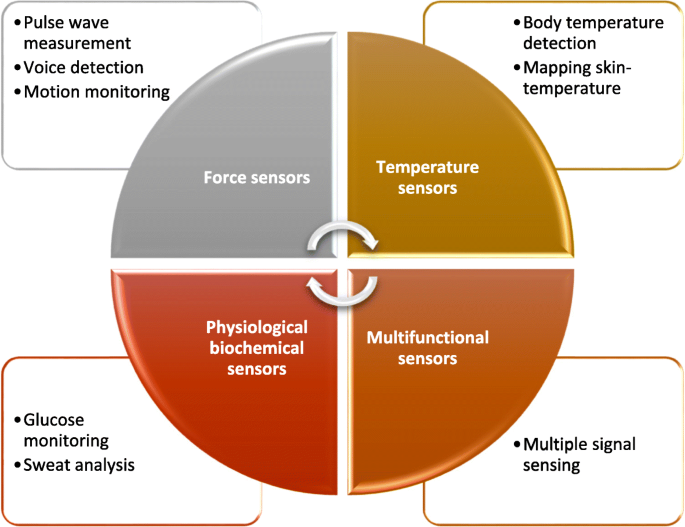
인체 건강 정보를 모니터링하기 위한 웨어러블 전자 제품의 최근 개발에 대한 시각적 요약
힘 센서는 장력, 압력, 토크, 응력, 변형률과 같은 기계적 힘의 값을 감지하고 이를 전기 신호로 변환할 수 있는 감지 장치입니다. 인체의 규칙적인 생리적 활동에 의해 발생하는 다양한 물리적 자극에는 심박수, 근육 운동, 호흡수, 혈압 등 중요한 건강 정보가 많이 포함되어 있습니다. 기존의 힘 센서는 대부분 금속과 반도체 소재를 기반으로 하기 때문에 부피가 크고 무겁고 휴대성과 유연성이 크게 제한되어 인체의 생체 신호를 모니터링하는 웨어러블 전자 장치에는 적용되지 않습니다. 기존의 힘 센서와 비교하여 플라스틱 및 엘라스토머 기판을 사용하는 유연한 힘 센서는 더 나은 생체 적합성, 신축성, 투명도, 착용성 및 연속 감지 기능과 같은 일련의 이점이 있습니다. 유연한 힘 센서는 저항률 센서, 용량성 센서 및 압전 센서로 나눌 수 있다는 점에 대해 아래에서 논의할 것입니다.
저항성 센서는 외부 자극에 의한 민감한 물질의 저항 변화를 전기 신호 출력으로 변환하는 센서입니다. 플렉시블 저항력 센서의 활물질은 일반적으로 그래핀[5,6], 탄소나노튜브(CNT)[7,8,9,10,11], 금속박막, 나노와이어, 입자[12,13,14] 및 전도성 고분자[15]를 탄성중합체(예:PDMS, PU, SEBS)로 변환합니다. 센서의 저항 변화는 주로 다음 세 가지 요인에 의해 발생합니다. 9,10, 13, 14] 및 (3) 서로 다른 재료 층 사이의 접촉 저항 변화[12, 11]. 압저항 센서는 낮은 전력 소비, 간단한 제조 공정 및 광범위한 적용으로 인해 널리 주목받고 있습니다[16].
미세 구조 표면이 있는 기판의 활용은 매우 민감한 압저항 힘 센서를 제작하는 효과적인 방법을 제공합니다. Fig. 2a, b, Choong et al. [15]는 센서의 압력 감도를 향상시키기 위해 마이크로 피라미드 폴리디메틸실록산(PDMS) 어레이를 사용하여 유연한 압저항 센서를 보고했습니다. 이 연구는 마이크로 피라미드 기판을 사용하면 압력이나 스트레칭에 의해 유도된 전도성 전극의 기하학적 변화를 최대화하여 감도를 크게 향상시킬 수 있음을 입증했습니다(그림 2c). 그림 2d에서 볼 수 있듯이 센서는 압력에 대한 좋은 선형 응답을 보입니다. 그러나 마이크로 피라미드 구조의 제작은 Si 몰드를 기반으로 하기 때문에 복잡한 제작 공정과 높은 비용이 소요되었다[1, 3]. Wang et al. [1]은 섬세한 실크 스카프 조각을 금형으로 사용하여 미세 패턴 PDMS 기판을 제작했습니다. 그들의 작업에서 독립형 단일벽 탄소 나노튜브(SWCNT) 초박막 필름이 미세 패턴 표면에 전사되었고 센서는 SWCNT/PDMS 필름의 두 층을 대면하게 배치하여 구성되었습니다. 실크를 주형으로 하여 제작한 표면 미세구조의 센서는 실시간 음성인식 및 맥박 감지에서 고감도, 빠른 응답시간, 우수한 안정성, 초저감지한계, 우수한 감지성능을 보였다. 또한, Su et al. [17]은 미모사 잎을 사용하여 미세 영역의 불규칙한 패턴을 가진 PDMS 박막을 보고했습니다. Wei et al. [18]은 연마된 유리 기판을 사용하여 마이크로돔 구조의 PDMS 필름을 생산했습니다. 이러한 노력은 미세구조의 대면적 박막 기판을 제조하는 간단하고 저렴한 방법을 제공하고 압저항 센서의 감도를 향상시키는 좋은 결과를 얻었습니다. 종이[4], 직물[19], 식물 및 식물 유래 생체재료[20, 21]와 같은 본질적으로 미세구조의 유연한 재료는 기질로 사용하기 위해 광범위한 관심을 불러일으켰습니다. Tao et al. [4]는 인간 활동을 감지하기 위한 그래핀/종이 기반 압력 센서를 보고했습니다. 그들은 티슈 페이퍼와 그래핀 옥사이드(GO) 용액을 혼합하여 GO 페이퍼를 얻었다. 건조 오븐에서 몇 시간 동안 가열한 후, GO 종이가 환원되어 rGO/종이 전도성 복합체를 얻었다. 0-20kPa의 압력 범위에서 종이 기반 센서의 감도는 티슈 페이퍼의 레이어 수에 따라 다릅니다. 8층 센서는 17.2kPa의 최대 감도를 달성합니다. −1 0–2 kPa 범위에서. 그래핀/종이 기반 압력 센서는 손목 맥박, 호흡, 말하기 및 동작 상태를 모니터링하는 데 큰 잠재력을 보여주었습니다. 또한 Yang et al. [19]는 폴리에스터 직물 기재에 열적으로 GO 시트를 그래핀 시트로 환원시켜 착용 가능한 스트레인 센서를 제조하였다. 짜여진 구조의 패브릭 기판은 센서에 매우 높은 음의 저항-변형률 계수 및 고유한 방향 감도를 포함하여 몇 가지 특별한 응답 특성을 제공했습니다. 준비된 섬유 변형 센서는 맥박, 입 움직임, 표정 등과 같은 사람의 움직임을 실시간으로 모니터링하기 위해 의류와 완벽하게 통합될 수 있습니다.
<사진>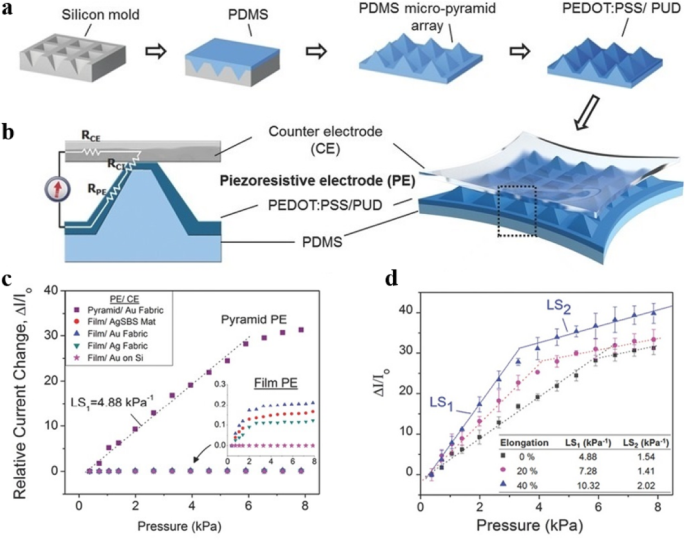
아 마이크로피라미드 PDMS 어레이의 제작 과정. ㄴ 외력을 받는 마이크로 피라미드 구조의 센서의 감지 원리 개략도. ㄷ 구조화되지 않은 센서에 비해 피라미드 센서의 감도가 향상되었습니다. d 늘어날 때 마이크로 피라미드 센서의 선형 압력 응답. 심판의 허가를 받아 수정했습니다. 10. Copyright 2014 John Wiley and Sons
2차원 또는 3차원 전도성 네트워크를 구성하기 위해 다공성 구조의 전도성 물질을 탄성체 매트릭스에 삽입하는 것은 저항력 센서에서 고감도를 달성하기 위한 또 다른 접근 방식입니다[7, 22, 23, 19, 24]. 외력에 의한 변형은 전도성 물질의 공간 분포 밀도를 변화시켜 센서의 저항을 변화시킵니다. 그림 3a에 표시된 것처럼 Wang et al. [7]은 해바라기 꽃가루(SFP) 마이크로캡슐과 다중벽 탄소 나노튜브(MWCNT)를 결합하여 중공 구 전도성 복합 재료를 제조한 다음 PDMS에 추가하여 MWCNT/PDMS 복합 필름을 제조했습니다. 이 MWCNT/PDMS 복합 필름을 두 개의 전도성 전극 사이에 끼워 E-피부 장치를 제작했습니다. 그림 3b–d에서 볼 수 있듯이, 평면 센서와 비교하여 꽃가루 기반 마이크로캡슐에 의해 도입된 이 중공 구 아키텍처는 센서가 더 높은 감도, 더 빠른 이완 시간 및 매우 높은 안정성을 나타낼 수 있도록 합니다. 센서는 사람의 손가락이나 사람의 목에 부착될 때 동적으로 압력과 변형을 동시에 감지할 수 있습니다. Li et al. [23]은 고온 열분해 공정을 통해 티슈 페이퍼를 탄소 페이퍼(CP)로 변환하여 다공성 전도성 네트워크를 구성하는 간단한 방법을 소개했습니다. 그림 3e는 탄소 종이의 SEM 이미지입니다. 카본 페이퍼와 PDMS 수지로 구성된 고감도 스트레인 센서는 간단한 진공 주입 공정을 통해 성공적으로 제작되었습니다. 다공성 구조는 센서를 적용된 변형률에 대해 매우 높은 감도로 만들었으며 기존 금속 센서보다 거의 10배 더 높습니다. 도 3f, 3에 도시된 바와 같이 CP/PDMS 센서는 벨트와 장갑을 각각 통합하여 성인의 호흡과 사람 손의 제스처를 모니터링하는 것을 시연한다. Lee et al. 전기방사 공정을 이용하여 다공성 구조를 갖는 감압 나노섬유를 제조하였다. 전도성 나노물질(CNT와 그래핀)을 나노섬유 내부에 균일하게 분산시켜 감지능력을 향상시켰다. 나노 다공성 구조로 인해 이러한 복합 나노 섬유를 사용하여 제조된 저항막형 압력 센서는 압력 유도 변형에 대한 높은 감도와 3차원 구조에 대한 우수한 순응성을 나타냈습니다.
<그림>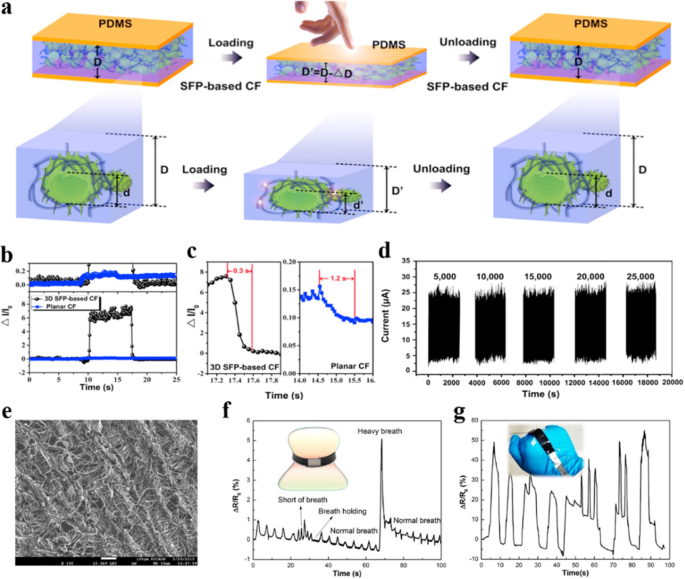
아 압력 하에서 해바라기 꽃가루 마이크로캡슐에 의해 유도된 속이 빈 구 구조의 센서 메커니즘의 개략도. ㄴ 600Pa 압력에서 SFP 기반 복합 필름(CF)과 평면 CF의 과도 응답. ㄷ 두 개의 관련 센서의 이완 시간. d 80 Pa에서 SFP 기반 CF의 안정성 테스트. ref. 3. Copyright 2017 엘스비어. 이 변환된 탄소 종이의 SEM 이미지. 에 , 지 호흡 모니터링(f ) 및 제스처(g ) CP/PDMS 센서에 의한 성인의. 심판의 허가를 받아 수정했습니다. 63. Copyright 2017 미국 화학 학회
정전 용량 센서는 정전 용량의 변화를 통해 외력의 변화를 나타내는 응답을 할 수 있습니다. 커패시터는 일반적으로 두 개의 전도성 플레이트로 샌드위치된 유전체 층으로 구성됩니다. 커패시턴스를 계산하는 데 사용되는 공식은 \( C=\frac{\varepsilon_0{\varepsilon}_rA}{d} \)입니다. 여기서 ε0 는 진공 유전율, εr 유전체의 상대 유전율, A 는 두 개의 전도성 판의 유효 중첩 영역이고 d 는 두 개의 전도성 판 사이의 간격입니다. 유연한 용량성 힘 센서의 전극은 일반적으로 CNT[25], Ag 나노와이어[26, 3] 및 전도성 이온 물질[27]을 사용합니다. PDMS, SEBS 및 Ecoflex를 비롯한 저탄성 탄성 재료는 유전층의 좋은 후보입니다.
정전 용량 센서의 감지 능력은 전극이나 유전체 층을 미세 구조화함으로써 크게 향상될 수 있습니다[3, 2, 28]. 그림 4a-d와 같이 Quan et al. [3]은 무광택 표면 유리를 템플릿으로 사용하여 유연한 정전 용량 센서용 전극 기판으로 미세 구조화된 PDMS 필름을 준비했습니다. 그들은 미세 구조 전극이 있는 센서를 없는 센서와 비교했습니다. 그림 4e–g의 결과는 미세 구조를 가진 센서가 더 높은 감도, 더 낮은 감지 한계 및 더 빠른 응답 시간을 나타냄을 보여줍니다. Kang et al. [28]은 스펀지와 같은 다공성 유전층을 기반으로 하는 고성능 정전용량식 압력 센서를 개발했습니다. 스펀지 같은 다공성 구조는 고분자 마이크로비드가 적층된 실리콘 기판에 PDMS를 코팅한 후 고분자 마이크로비드를 용해시켜 달성했다. 그런 다음 다공성 PDMS 필름을 ITO 박막 전극으로 전사하여 초고감도 및 높은 안정성을 가진 정전 용량 센서를 생성했습니다. 다공성 PDMS 압력 센서의 감도는 베어 PDMS 필름 기반 센서보다 8배 이상 높습니다. 미세구조의 정전용량형 센서의 성능이 더 좋은 이유는 다음의 두 가지 점에서 찾을 수 있다. 우선, 엘라스토머 전극 기판 또는 유전층을 구조화하면 장치의 압축성이 향상됩니다. 다른 예로, 마이크로아키텍처는 커패시터의 전도성 판 사이에 규칙적인 방식으로 공극을 추가하여 유전율을 압력 하에서 변경할 수 있도록 합니다. 센서에 외력을 가하여 변형을 일으키면 유전층의 공극의 전체 부피가 감소하고 공기/엘라스토머 하이브리드 유전층의 유전율이 증가하여 정전용량형 센서의 정전용량 값 상승은 두 가지 원인으로 인해 발생합니다. 요인:판 간격의 감소 및 유전율의 증가. 또한, Pang et al. [2]는 그림 5a, b에 표시된 것처럼 피라미드 모양의 PDMS 유전층과 마이크로헤어 구조의 계면을 가진 고감도 압력 센서를 개발했습니다. 그림 5c–f는 서로 다른 인터페이스 형상을 가진 4개의 센서로 요골 동맥 테스트 결과를 비교했는데, 이는 미세털 인터페이스가 용량성 압력 센서의 신호 대 잡음비를 분명히 향상시킬 수 있음을 보여줍니다.
<그림>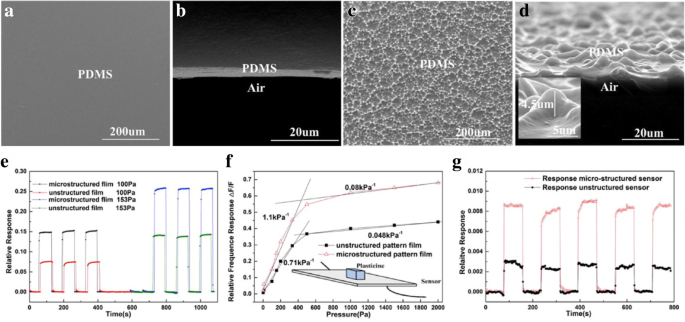
아 –d 평면도의 SEM 이미지(a ) 및 측면도(b ) 구조화되지 않은 PDMS 필름, 평면도의 SEM 이미지(c ) 및 측면도(d ) 미세 구조 PDMS 필름. 이 다른 구조를 가진 센서의 상대적 응답 비교. 에 두 개의 구조화된 센서의 감도 테스트. 지 1 Pa 압력에서 두 개의 구조화된 센서의 응답. 심판의 허가를 받아 수정했습니다. 18. Copyright 2017 엘스비어
<그림>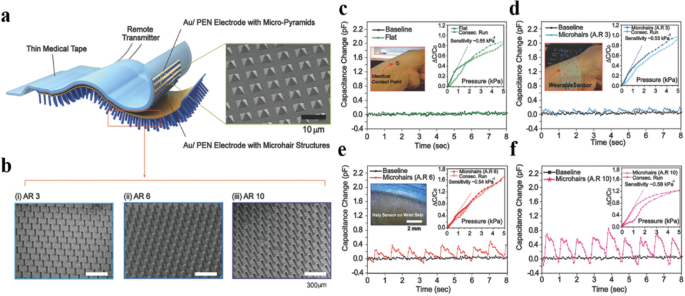
아 마이크로헤어 구조 센서의 개략도. ㄴ 종횡비가 다른 미세모발 구조의 SEM 이미지. ㄷ –f 인터페이스 형상이 다른 4개의 장치를 사용한 요골 동맥 검사:c 평평한 표면, 종횡비가 d인 미세털 구조 3, e 6 및 f 10
감도를 향상시키기 위해 유기 전계 효과 트랜지스터(OFET)와 통합하는 것도 용량성 센서에 대해 널리 연구되는 프로젝트입니다. OFET 장치에서 소스-드레인 전류는 게이트 유전체 커패시턴스에 직접적으로 의존합니다. Schwartz et al. [29]는 유전체 층으로 미세 구조의 PDMS 필름을 사용하고 반도체로 폴리이소인디고비티오펜-실록산(Polyisoindigobithiophene-siloxane, PiI2T-Si)[30]이라는 새로운 공액 폴리머를 사용하는 고감도 OFET E-스킨 장치를 보고했습니다. 미세구조 PDMS 유전체를 통합한 OFET 장치는 초고감도(8.4kPa - 1) 저압 체제에서 <8kPa 뿐만 아니라 빠른 응답 시간(<10ms). 이러한 우수한 기능은 이러한 장치가 손목 맥파의 충실도 측정에 유망하다는 것을 입증했습니다.
저항성 센서와 비교할 때 정전 용량 센서는 일반적으로 감도가 더 높고 감지 한계가 더 낮습니다. 그러나 열악한 선형성 응답과 기생 커패시턴스 및 프린징 커패시턴스에 대한 민감성은 실제 애플리케이션에서 문제가 될 수 있습니다.
압전 효과는 기계적 자극이 일부 이방성 결정 물질을 변형시키고 내부 쌍극자의 분극을 유발하여 결정의 대향하는 두 표면 사이에 존재하는 전위차를 유발하는 현상을 나타냅니다. 압전 재료의 고유한 특성으로 인해 응답 시간이 빠른 압전 센서는 고주파수 동적 신호를 효율적으로 측정할 수 있으며 자체 전원 장치에 매우 유망합니다.
플렉서블 센서에 일반적으로 사용되는 압전 재료로는 P(VDF-TrFE)[31, 32], ZnO[33], PbTiO3[34], PZT[35, 36] 등이 있습니다. P(VDF-TrFE)는 가장 대표적인 것 중 하나입니다. 유연성, 간단한 제조 공정, 놀라운 안정성 및 큰 압전 계수로 인해 유연한 압전 센서에 선호되는 재료입니다. Persano et al. [31]은 전기방사에 의해 준비된 정렬된 P(VDF-TrFE) 섬유 어레이를 기반으로 하는 유연한 압전 센서를 보고했습니다. 이 간단한 압력 센서는 매우 작은 압력 영역(약 0.1Pa)에서도 우수한 감지 성능을 나타냅니다. 결과는 인간의 움직임 감지 및 로봇 전자공학 분야에서 놀라운 응용 가능성을 제시했습니다. 무기 재료는 유연성이 부족하지만 많은 나노 규모의 무기 재료와 고분자-세라믹 나노복합체(ZnO NW[33], PZT 나노리본[35] 및 나노시트[36], P(VDF-TrFE)/BaTiO3 나노복합체[4])는 어느 정도의 유연성을 나타낼 수 있습니다. Shinet al. [33]은 PDMS에 충전된 리튬(Li) 도핑된 ZnO NW를 감지 요소로 사용했습니다. Li 도핑된 ZnO NW-PDMS 복합 재료의 압전 출력 전압은 적용된 힘과 주파수의 함수였습니다. 제작된 장치는 인간의 움직임에 대한 즉각적인 정보를 제공할 수 있으며, 이는 인간 활동 모니터링에 전자 피부 장치를 적용하는 데 매우 중요합니다. 압전 센서는 동적 물리적 자극의 감지에 특히 유용하지만 정적 신호의 측정에는 잘 수행되지 않습니다. 압전 물질에서 발생하는 전압 신호는 압력을 가하거나 빼는 순간에만 나타나기 때문입니다. 이 문제를 해결하기 위해 Chen et al. [34]는 PbTiO3에 기반한 정적 측정을 위한 유연한 압전 압력 센서를 보고했습니다. 나노와이어(PTNW)/그래핀 헤테로구조. 이 장치에서 PTNW의 변형에 의해 유도된 분극 전하는 그래핀에서 하전된 불순물로 작용하여 캐리어 이동도에 영향을 줍니다. 작동 메커니즘은 PTNW의 분극 전하가 그래핀에서 캐리어의 산란을 증가시켜 캐리어 이동도를 감소시킨다는 것입니다. 앞서 언급한 메커니즘을 기반으로 그림 6과 같이 이 이종 구조 센서는 고유 CVD 성장 그래핀 압력 센서[37, 38]보다 더 높은 감도를 가지며 정적 기계적 신호를 측정할 수 있었습니다.
<그림>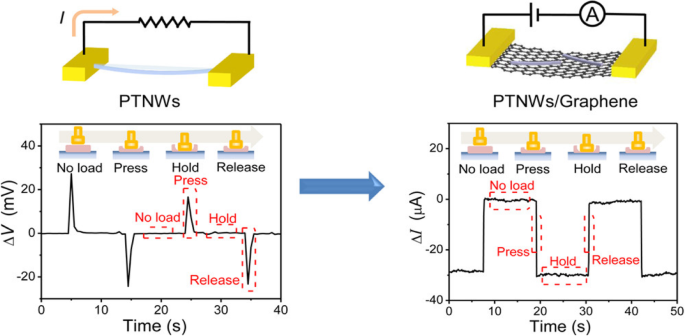
PTNW 기반 압력 센서(왼쪽)와 압력 펄스에서 PTNW/그래핀 트랜지스터의 압력 응답. 심판의 허가를 받아 수정했습니다. 25. Copyright 2017 미국 화학 학회
온도 감지는 감지 장치의 중요한 부분입니다. 체온은 사람의 몸 상태를 크게 반영할 수 있습니다. 건강한 사람의 심부체온은 비교적 일정하며 일반적으로 36.2~37.2°C입니다. 쉘 온도는 물리적 조건과 주변 온도 모두에 영향을 받을 수 있지만 환경에 영향을 받지 않습니다. 체온의 비정상적인 변화는 일반적으로 건강이 좋지 않음을 나타냅니다. 예를 들어, 체온 상승은 열이나 감염의 증상이며, 체온 저하는 아마도 빈혈을 의미할 수 있습니다. 전자 피부 장치의 실시간 온도 감지를 위해 다양한 유형의 유연한 온도 센서가 개발되었습니다.
민감한 물질의 저항 변화를 통해 온도를 감지하는 것은 피부와 같은 전자 장치에서 가장 일반적으로 사용되는 온도 측정 방법입니다. 저항 온도 계수(TCR)는 저항 온도 센서의 감도를 나타내는 중요한 지표입니다. 온도가 1°C 변할 때 저항의 상대적 변화로 정의됩니다. 다양한 저항 온도 센서가 순수 금속 원소(Pt, Au, Cu)[39,40,41,42], 금속 산화물 입자[43], 탄소 나노튜브(CNT) 고분자 복합 재료[8, 9] 및 그래핀을 사용하여 보고되었습니다. [44, 45] 민감한 물질로.
금속은 온도 감도로 인해 오랫동안 온도 감지에 사용되었습니다. 검출 메커니즘은 온도 상승이 격자의 열 진동을 강화하여 전자파의 산란을 강화하여 저항을 증가시킨다는 사실로 설명할 수 있습니다. 기존의 금속 기반 온도 센서는 제한된 신축성 또는 굽힘성을 제공합니다. 주름 좌굴, 인라인 말굽형 구조 및 강성 섬 설계[39, 41, 46]와 같은 구조 공학은 한계를 극복하는 효과적인 방법으로 인증되었습니다. 그림 7a, b, Yu et al. [39]는 탄성 기판에 주름진 박막 감지 요소를 기반으로 하는 신축성 온도 센서를 개발했습니다. 센서는 미리 연신된 30% 유연한 기판에 얇은 Cr/Au 필름(5nm/20nm)을 스퍼터링 증착하여 제작되었습니다. 그림 7c, d에서 볼 수 있듯이 사전 변형을 해제하여 형성된 주기적 물결 형상은 장치가 성능을 변경하지 않고 기계적 변형을 최대 30%까지 늘릴 수 있도록 합니다. Webb et al. [41]은 마이크로리소그래피 기술에 의해 제조된 구불구불한 형태의 얇은(50nm), 좁은(20μm) 금박막을 사용하는 초박형, 순응성 피부 유사 온도 센서 어레이를 보고했습니다. 고급 모델링 및 분석 기술로 구현했을 때 신축성 있는 전자 시스템은 밀리켈빈 정확도로 껍질 온도를 비침습적으로 매핑할 수 있었습니다.
<그림>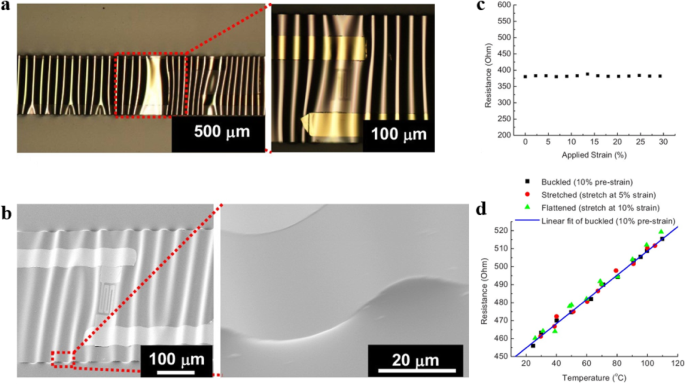
아 주기적으로 물결 모양 패턴이 있는 신축성 센서의 개략도. ㄴ 신축성 온도 센서의 SEM. ㄷ 센서 스트레인이 2.25%에서 30%로 지속적으로 늘어날 때 센서의 저항 값의 변화. d 변형률이 0%, 5%, 10%인 신축성 센서의 저항과 온도 사이의 관계. 심판의 허가를 받아 수정했습니다. 29. Copyright 2009 AIP 퍼블리싱
위에서 언급한 작업은 금속 기반 온도 센서의 유연성을 효과적으로 개선했지만 이러한 장치에 사용된 구조 엔지니어링 방법은 신축성을 25~30%로 제한했습니다. 유연한 온도 센서의 인장 한계를 더욱 뛰어넘기 위해서는 본질적으로 신축성이 있는 재료를 사용해야 합니다. Harada와 동료[8, 9]는 인쇄 공정으로 제조된 폴리(3,4-에틸렌디옥시티오펜)-폴리(스티렌 설포네이트)(PEDOT:PSS)-CNT 복합 필름을 기반으로 하는 유연한 온도 센서를 도입했습니다. PEDOT:PSS-CNT 혼합 온도 센서의 감도는 CNT 페이스트와 PEDOT:PSS 용액의 다양한 복합 비율에서 0.25 ~ 0.63%/°C로 금속 기반 온도 센서보다 우수합니다[39,40,41, 42]. Fig. 8a, b, Yan et al. [45]는 미세다공성 구조를 갖는 그래핀 검출 채널을 제조하기 위해 리소그래피 여과법을 이용하여 신축성 그래핀 기반 서미스터를 개발하였다. 이 장치는 최대 50%의 높은 고유 신축성을 나타내며 그림 8c, d에 표시된 것처럼 TCR은 기계적 변형에 의해 효과적으로 조정될 수 있습니다. 그러나 센서를 늘리거나 비틀면 서미스터의 저항이 변경될 수 있으므로 변형 의존성은 웨어러블 감지에 이상적이지 않습니다. 센서 변형의 경우 단일 수치 신호에서 변형률 및 온도 값을 읽을 수 없습니다. 본질적으로 신축성 있는 재료로 준비된 서미스터에서 온도 감지에 대한 변형 효과의 영향을 피하는 것은 여전히 어려운 일입니다. 높은 신축성과 변형 적응성을 동시에 얻기 위해 Zhu et al. [47]은 차동 회로를 설계하여 변형 억제 기능을 갖춘 CNT 트랜지스터 기반 온도 센서를 보고했습니다(회로도는 그림 8e, f에 표시됨). 반도체 채널로 패턴화된 초분자 폴리머 분류 SWCNT를 가진 단일 신축성 박막 트랜지스터가 온도 감지 장치로 제작되었습니다. 조밀한 정렬되지 않은 SWCNT 네트워크와 비극성 SEBS 박막이 각각 소스-드레인 및 게이트 전극과 게이트 유전체로 사용되었습니다. 주요 메커니즘은 반도체 SWCNT 네트워크에서 전하 수송의 온도 의존성에 기인할 수 있습니다[48]. 그림 8g, h와 같이 정적 차동 회로 구성을 사용하여 변형 유도 문턱 전압 이동을 무효화했습니다. 차동 출력 전압(VOD ) 따라서 두 가지가 일치하는 한 억제할 수 있습니다.
<그림>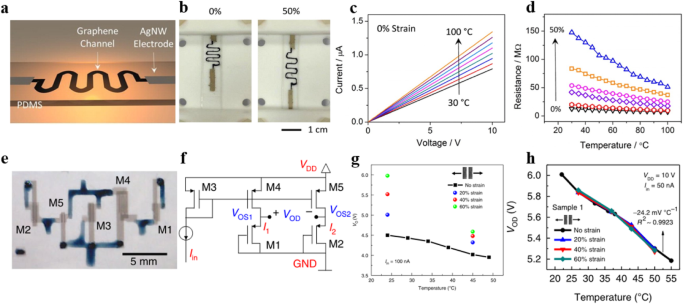
아 그래핀 서미스터의 신축성 있는 개략도. ㄴ 0% 및 50% 변형률에서 그래핀 서미스터의 이미지. ㄷ 온도에 따른 저항 변화. d 0–50% 변형률 내에서 온도에 따른 저항 변화. 심판의 허가를 받아 수정했습니다. 35. 저작권 2015 미국 화학 학회. 이 5개의 TFT로 구성된 신축성 온도 감지 회로의 광학 현미경 사진. 에 정적 차동 감지 방식의 회로도. 지 단일 TFT의 온도 감지 성능. 아 신축성 정전기 차동 회로 감지 장치의 온도 감지 성능. 심판의 허가를 받아 수정했습니다. 39. Copyright 2018 Springer Nature
이러한 TFT 구조 장치가 온도 센서의 감도를 크게 향상시키는 것으로 다른 연구자들에 의해 입증되었다는 점은 언급할 가치가 있습니다. Trung et al. [44] 웨어러블 전자 제품을 위한 신축성 저항 및 게이트 온도 센서를 제작하고 두 유형의 센서 간의 성능 차이를 비교했습니다. The temperature sensing layer was a composite conductive material formed by inserting temperature-responsive R-GO nanosheets into an elastomeric PU matrix. According to their test results, gated devices achieved higher temperature sensitivity (1.34% per °C) than resistive devices (0.9% per °C).
A variation of temperature will change the remnant polarization of pyroelectric materials thus generating opposite bound charges on both surfaces of the crystal. Materials that have been found to exhibit pyroelectricity include different ceramics (PZT, LiTaO3 , LiNbO3 ) and polymer (PVDF, P(VDF-TrFE)) [49,50,51,52,53]. A lot of pyroelectric devices have been fabricated on rigid substrate and widely used in missile detection, fire alarm, and other fields. Nevertheless, flexible pyroelectric devices still need to be explored. In particular, P(VDF-TrFE) is ideal for temperature sensing applications in flexible electronics. Tien et al. [51] directly used a highly crystalline β-phase P(VDF-TrFE) material with extremely large remnant polarization as gate insulator in an OTFT structure for temperature sensing. The remnant polarization inside the P(VDF-TrFE) can change with temperature, causing a change in the density the holes accumulated at the interface between the semiconductor channel and P(VDF-TrFE). Therefore, the source-drain current increases as the increase of temperature. The linear response of the device in a certain temperature range and its simple fabrication process suggest its potential application in flexible temperature sensors. However, for (P(VDF-TrFE)), the pyroelectric effect is indistinguishable from the piezoelectric effect, which means that mechanical deformation will interfere with temperature detection. To decouple strain-induced interference from temperature effect, Tien et al. [54] developed flexible pyroelectric OFET devices with piezo- and pyroelectric nanocomposite gate dielectrics formed by a mixture of (P(VDF-TrFE)) and BaTiO3 nanoparticles as well as piezo- and thermoresistive organic semiconductor channel(pentacene). The fabricated devices can extract effects from the target sensing signals successfully while the flexible sensor is under multiple stimuli because the two chosen materials were able to respond to strain and temperature in a disproportionate manner simultaneously. This approach is able to distinguish the temperature effects from strain for flexible pyroelectric sensors.
In order to understand all aspects of human health, various physiological biochemical sensors have been developed for analysis of vital biochemical signs, such as blood glucose [55, 56, 57, 58] and body fluids (sweat, interstitial fluids, saliva, and tears) [59, 60, 61]. Flexible biochemical sensors typically adopt chemical methods to detect the composition and amount of a biological substance. The chemical reaction between the sensing material and the target detection substance changes the electrical properties of the sensor, therefore the physiological health information can be obtained by analyzing the electrical parameters of the sensor.
Continuous measurement of glucose is vital to maintain the health and quality of life of diabetics. Commercially available products for glucose detection are performed by invasive lancet approaches that requires sampling the patient’s blood, leading to pain to the patient. New electronics fabrication techniques on flexible substrates have been developed to enable noninvasive wearable glucose monitoring. Chen et al. [55] developed a skin-like biosensor for noninvasive blood glucose monitoring via electrochemical channels. The detection mechanism and structure of this sensor are shown in Fig. 9a, b. A paper battery was attached to the skin to produce subcutaneous electrochemical twin channels (ETCs), through which more intravascular blood glucose was expelled from the blood vessel and transported to the skin surface. The outward-transported glucose thus can be measured easily by a glucose oxidase (GOx) immobilization layer. The experimental test results are shown in Fig. 9c, d. As can be seen from the figure, the monitoring results of the biosensor are in good agreement with the results of the commercial glucometer. Besides glucose monitoring, sweat analysis can be important in facilitating insight into an individual’s heath state. For example, sweat glucose is metabolically related to blood glucose and low electrolyte levels in sweat may be a sign of dehydration. Gao et al. [61] presented a highly integrated wearable sensing system for multiplexed in situ sweat analysis. As shown in Fig. 9e, f, the sensing system composed of four different sensing elements for simultaneous and selective screening of a panel of biomarkers in sweat—sodium (Na+), potassium (K+), sweat glucose, and sweat lactate. They also exploited a flexible printed circuit board (FPCB) to realize the conditioning, processing, and wireless transmission of critical signals. According to the test results in Fig. 9, it can be seen that the wearable system can be used to measure the detailed sweat characteristics of a human subject and to evaluate the physiological state of the object in real time.
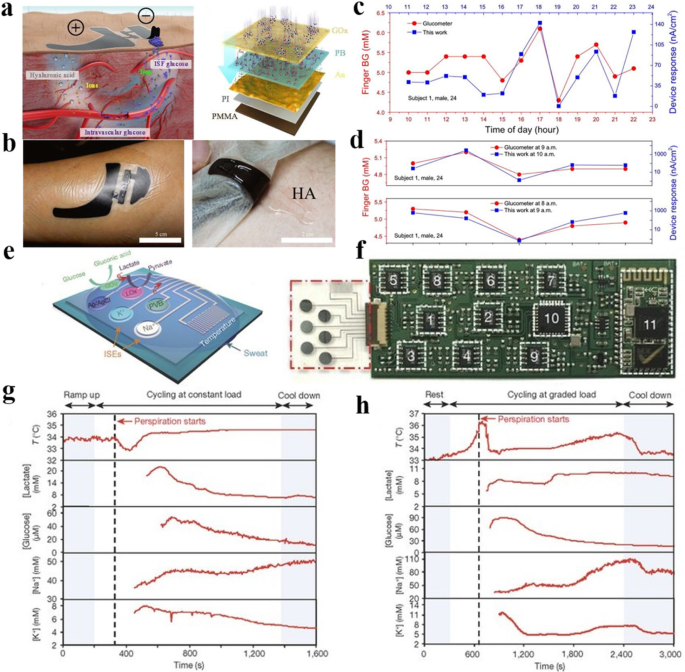
아 Schematic of the ETCs (left) and the biosensor multilayers (right). ㄴ A biosensor attached to skin surface for glucose monitoring. ㄷ Results of glucose monitoring in one day by a glucometer and a biosensor. d Results of glucose monitoring in 5 days by a glucometer and a biosensor. Adapted with permission from ref. 48. Copyright 2017 American Association for the Advancement of Science. 이 Schematic of the sensor system for multiplexed sweat analysis. 에 Photograph of a flexible integrated sensing device. 지 The result of sweat analysis by wearing the sensor on the forehead of the subject. 아 The result of sweat analysis by wearing the sensor on the forehead of another subject. Adapted with permission from ref. 54. Copyright 2016 Springer Nature
Integrating multifunctional sensing components into one device is an important advance in wearable electronics. Future wearable electronics should enable to integrate the function of detecting multiple signals such as strain, pressure, temperature, humidity, gas [8, 9, 62, 63], and so on into a single device to provide more comprehensive human health and environmental information. Laminating multiple layers of thin film e-skin device with different sensing functions together is the major method to prepare multifunctional sensors. Harada et al. [8] fabricated a triaxial tactile sensor and temperature sensor array to simultaneously detect the tactile forces, slip forces, and temperature by using a printing manufacturing technique. Four strain sensors printed by a screen printer were designed with a PDMS fingerprint for a pixel, as shown in Fig. 10a, b. Three-axis force directions can be detected by characterizing the strain distribution at the four integrated force sensors with a finite element method (FEM). Figure 10c shows the measurement results of the multifunctional sensor when touching a fingerprint-like structure with a human finger. The integrated strain/temperature sensing array for e-skin application show good performance in imitating human skin. Ho et al. [62] developed a multimodal all graphene e-skin sensor matrix. Three different sensors—humidity, thermal, and pressure sensors—were included in this matrix. Sprayed graphene oxide (GO) and reduced graphene oxide (rGO) were used as active sensing materials for the humidity and temperature sensors, respectively. Whereas the top PDMS substrate sandwiched between two CVD-graphene electrodes acted as the capacitive strain sensor, as displayed in Fig. 10d, e. The three sensors were integrated into a single unit through a simple lamination process. As can be seen from the test results in Fig. 10f–h, each sensor is sensitive to its associated external stimulus, but not affected by the other two stimuli. These results indicate that the E-skin device offers unique opportunities for healthcare applications in the future.
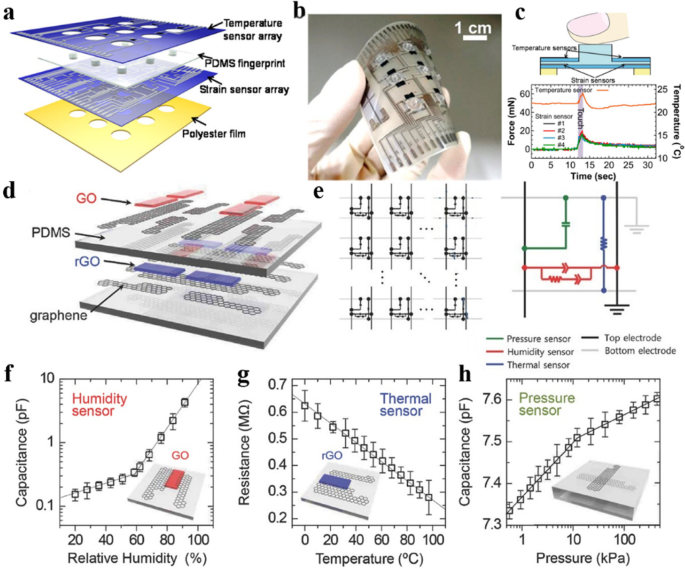
아 Schematic for the structure of multilayer sensor. ㄴ Picture of a 3 × 3 sensor array. ㄷ schematic and measurement results of the multifunctional sensor when touching a fingerprint-like structure with a human finger. Adapted with permission from ref. 4. Copyright 2014 American Chemical Society. d Schematic diagram of the multimodal e-skin sensor. 이 Circuit diagram of the sensor matrix. 에 Performance of the humidity sensor based on GO. 지 Performance of the temperature sensor based on rGO. 아 Performance of the pressure sensor based on PDMS. Adapted with permission from ref. 55. Copyright 2016 John Wiley and Sons
In order to develop highly integrated wearable system for applications in health monitoring, physical state assessment, and telemedicine, researchers have tried various manufacturing processes and device structures to combine different functions together. Self-powered modules working continuously without external power sources should be an integral part of future wearable electronics. In addition, for real-life application of wearable electronics in monitoring critical health information, a wireless digital system for processing and transmitting signals over long distances is necessary.
To realize independent operation of wearable sensors, nanogenerators based on piezoelectric, pyroelectric, and triboelectric effects have been developed to incorporate into wearable systems [64,65,66,67]. Nanogenerators are able to harvest mechanical energy or thermal energy from human activities to power wearable devices. Zi et al. [64] developed a tribo-, pyro-, and piezoelectric hybrid cell that is composed of a sliding mode triboelectric nanogenerator (TENG) and a pyroelectric-piezoelectric nanogenerator (PPENG) for self-powered sensing. The structure and working principle of the hybrid cell are shown in Fig. 11a–d. The TENG, fabricated with a piece of aluminum foil as the sliding layer and a piece of polytetrafluoroethylene (PTFE) film deposited on Cu electrode as the static layer, is able to harvest the sliding mechanical energy. The PPENG was fabricated by depositing a piece of PVDF with Cu electrodes on both sides to harvest the thermal energy generated by friction and the mechanical energy generated by the normal force. As can be seen from Fig. 11e–j, the hybrid cell is demonstrated as an efficient power source that can drive the LED with extended lighting time, and a versatile self-powered sensor for detecting both the subtle temperature alteration and strain on the surface of human skin. Nevertheless, the rapid development of flexible electronics places higher demands on corresponding power devices, which should be comparably flexible or stretchable. Pu et al. [65] reported a soft skin-like triboelectric nanogenerator that achieves ultrahigh stretchability (maximum stretch up to 12.6 or strain of 1160%) and high degree of transparency (96.2%) by using PDMS or LED as the elastomer electrification layer and PAAm-LiCl hydrogel as the electrode. This skin-like generator is capable of outputting an open circuit voltage of up to 145 V and an instantaneous power density of 35 mW m −2 through harvesting biomechanical energy. Meanwhile, the TENG-based electronic skin can serve as a tactile sensor to sense pressure and achieved a sensitivity of 0.013 kPa −1 . The development of self-powered, wearable platforms has opened up opportunities for many potential applications including soft robots, smart artificial e-skins, wearable electronics, etc. However, there are still limitations of flexible energy harvesting devices because the power generation of nanogenerators that have been reported so far cannot meet the needs of practical applications.
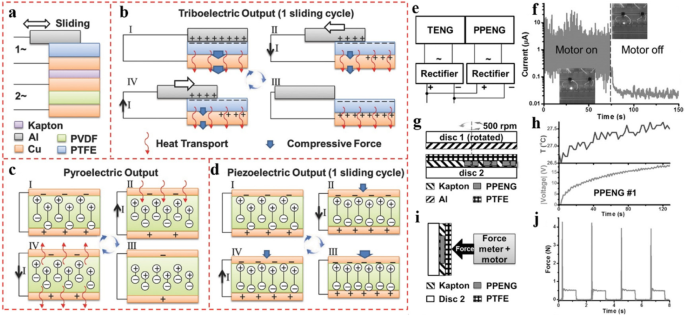
아 –d The structure and working principle of the tribo-, pyro-, and piezoelectric hybrid cell. 이 The circuit that hybridizes TENG and PPENG outputs. 에 The LED was lighted by the hybridized output current. 지 The schematic diagram of the structure used to demonstrate the temperature sensing. 아 The voltage and the temperature variation of the PPENG. 나 The schematic diagram of the measurement setup. j A force of approximately 0.5 N applied to the surface. Adapted with permission from ref. 56. Copyright 2015 John Wiley and Sons
The integration of flexible sensors with information processing system is the next frontier for wearable electronics. Current research on flexible electronics mainly focused on the fabrication and optimization of sensing elements, while the research on flexible electronic circuits for information processing is relatively limited. The delivery and processing of human health information collected by the sensor still needs to be done by a computer. Wireless transmission of sensor data that has been reported so far is principally realized by combining a flexible sensor with a rigid silicon-based digital circuit technology. Pang et al. [2] built a custom wireless measurement system based on an XBee Series 2 radio module integrating to a programmed Arduino microcontroller. This system allows the sensor data to be wirelessly transmitted to a computer but is relatively bulky and not portable. Gao et al. [61] devise a multiplexed sensing system that integrated the functions of signal conditioning, processing, and wireless transmission by merging commercially available technologies of consolidating integrated circuits on a flexible printed circuit board (FPCB), with flexible sensor technologies fabricated on elastic substrates. The introduction of FPCB technology bridges the technological gap between signal conditioning, processing, and wireless transmission in wearable sensors to some extent, but the flexibility and comfort of the system still do not meet the requirement of next-generation wearable electronics. Realizing skin electronics rely on the development of intrinsically stretchable circuits [68].
In past several years, the rapid development of wearable electronics attracts extensive attention. Researchers have made many fruitful attempts and achieved good results in developing wearable electronics with high sensitivity, flexibility, and stability. This review analyzed recent research strategy and advancements in wearable electronics for human health detection from the aspects of force sensors, temperature sensors, physiological biochemical sensors, multi-functional sensor, and other functional modules applied in flexible electronics. The successful fabrication of flexible sensing devices with high sensitivity, low-cost, portability, and long-term stability indicates that flexible and wearable electronics will definitely become the mainstream in the field of medical care in the future. However, there are certain challenges remaining for practical applications of current wearable sensors in real life.
Wearable electronic devices should be able to clearly identify the deformations caused by pulse, muscle movements, and external contact. While most of the flexible force sensors that have been reported so far cannot accurately identify the source and direction of external forces.
<리> 2.In terms of temperature sensors, it is still difficult to achieve high stretchability, sensitivity, and strain adaptability simultaneously. Improving the sensing performance and eliminating the influence of the elastic deformation of the sensor on temperature detection remain important research topics.
<리> 3.The detection accuracy of flexible physiological biochemical sensors is insufficient compared to traditional medical devices. Besides, most of the valuable physiological health information needs to be extracted from internal secretions. More biophilic implantable materials should be taken into consideration for the development of biochemical sensors to extract information from blood and muscles.
<리> 4.Multifunctional sensors should be able to simultaneously detect pressure, stress, temperature, and other different signals such as humidity and gas atmosphere and avoid crosstalk between them. The realization of multifunctional sensors requires further development of new materials, nanotechnology, and device structure design.
<리> 5.Processing the data in situ and transmitting them in real time are also essential parts of future wearable electronics. It is quite challenging to integrate multiple functional modules into a complete wearable system so that it can fully meet the requirements of practical applications.
Not applicable.
Aurum
Cuprum
화학 기상 증착
발광 다이오드
나노와이어
Organic field-effect transistor
Poly(vinylidenefluoride-tirfluoroethylene)
Polyacrylamide
Lead titanate
폴리디메틸실록산
Platinum
Polyurethane
납 지르콘산 티탄산염
Styrene-ethylene-butylene-styrene block copolymer
Very high bond
산화아연
나노물질
초박형의 유연한 컴퓨터 회로는 수년 동안 엔지니어링 목표였습니다. 그러나 기술적 장애물로 인해 고성능을 달성하는 데 필요한 소형화 정도가 방지되었습니다. 이제 Stanford University의 연구원들은 이전보다 몇 배 작은 길이인 100나노미터 미만의 유연하고 원자적으로 얇은 트랜지스터를 생성하는 제조 기술을 발명했습니다. 연구원들은 이러한 발전으로 소위 플렉스트로닉스(flextronics)가 현실에 더 가까워졌다고 말했습니다. 유연한 전자 장치는 인체에 착용하거나 인체에 이식하여 수많은 건강 관련 작업을 수행할 수 있는
원격 모니터링이나 원격 관리는 직원들이 원격으로 일하는 요즘 매우 중요합니다! 조직이 제시간에 작업을 완료하려면 유지 관리가 매우 중요하다는 것을 알고 있습니다. 조직이 작으면 작은 유지 관리 문제를 무시하고 모두 합쳐져 큰 위기로 변합니다. 이 위기는 비즈니스에 큰 타격을 줍니다! 다음은 IT 조직의 예입니다. 네트워크 문제로 인해 시스템이 작동하지 않고 전체 다운타임으로 인해 수익 손실이 발생하고 고객 충성도도 손상될 수 있다고 가정합니다. 따라서 시스템이 항상 올바르게 작동하고 다운타임을 줄이는 것이 회사의 첫 번째 목표